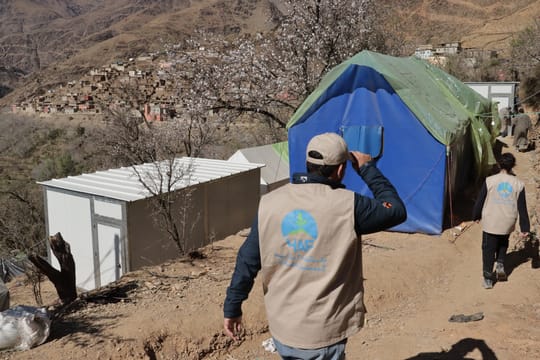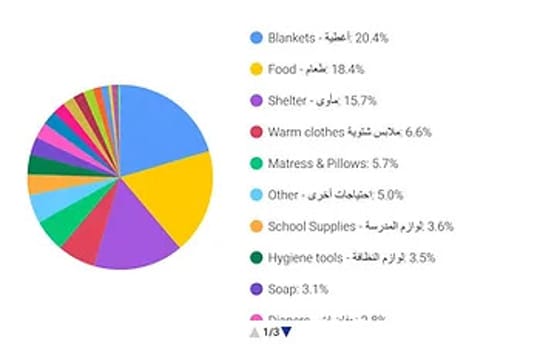Building Resilient Communities: Lessons from the Al Haouz Earthquake Recovery

On the International Day for Disaster Risk Reduction, the High Atlas Foundation (HAF) and the New Era Association (NEA) organized a community meeting within the Promoting Civil Society and University Engagement program funded by the National Endowment for Democracy. The event highlighted global efforts to enhance disaster preparedness and protect vulnerable communities. This occasion aimed to build community resiliency and better prepare people for disasters through knowledge exchange and awareness.
The community gathering on October 28th began with a moment of silence to commemorate the lives lost in the September 8th earthquake. This was followed by a documentary screening and photography exhibition that displayed the tragic events following the earthquake.
The consultative meeting was led by community activist Abderazaq Amdjar, who began the event with words of gratitude to the attendees:professors, research students, engineers, and individuals interested in local affairs. He acknowledged the efforts of HAF and NEA in providing platforms for valuable discussions related to vulnerable areas in the context of disaster response.
The meeting addressed various dimensions:
Urban Dimension: Mr. Abdelhafid El Garmai, representing the regional branch of the National Union of Moroccan Engineers, provided a comprehensive overview of regional and social disparities and the role of the government in disaster management. He discussed the significant efforts made by civil and military authorities and social sectors in assisting affected families. He emphasized the importance of activating disaster governance on an international level in the future.
Legal Dimension: Ms. Amina Assadik, a trainee at the Legal Clinic in Marrakech, presented an analysis of the urban planning law and the management of the Hoz earthquake crisis. She highlighted the consequences of this tragic event and pointed out that Moroccan law includes a special decree for earthquake prevention but is limited to urban buildings, excluding rural structures. She also raised questions about the ease of reconstruction procedures and whether authorities would assist affected individuals or impose obstacles and delays.
Media Dimension: Journalist Amina Aboulghannaim provided insights into the role of media in the Al Haouz earthquake incident. She emphasized the importance of verifying the accuracy of news and not succumbing to fake news. She also raised important questions about the media's ability to provide early warnings of earthquake risks and its role as a fourth estate.
Psychological Dimension: Dr. Fatima Zahra El Fahri, a specialist in psychiatric medicine, offered guidance on addressing post-crisis stress disorders and the importance of psychological care. She pointed out that shocks can lead to psychological disorders, including depression and other symptoms. She also provided methods and approaches for preventing mental health issues and promoting the mental well-being of affected individuals.
Social Dimension: Mr. Youssef Mazdou, HAF Program Assistant, presented an overview of the efforts made by the foundation in aiding the earthquake victims. This involved providing various forms of assistance and collecting data, and statistics, which the foundation has covered in the affected areas since the beginning of the earthquake until now.
The attached table provides a summary of HAF's efforts in the affected areas since the earthquake. The psychosocial empowerment workshops have demonstrated a significant positive impact on the mental health and overall well-being of the participants. Through various psychosocial activities, individuals experience coping mechanisms and a sense of empowerment in dealing with the challenges posed by the earthquake's aftermath. Up to date, the HAF conducted 19 psychosocial empowerment workshops in 18 villages, benefitting up to 450 women and 300 kids.
The September 8th earthquake has brought the needs of rural Moroccan communities to a global spotlight, and our response must be an investment in strategic, sustainable infrastructure.
By providing access to clean water sources for drinking, sanitation, and hygiene, we invest in prevention. Water borne illnesses are the leading cause of disease, and water infrastructure exponentially decreases infant and child mortality rates, general illness, infection rates, and other critical metrics for public health. Our earthquake response recognizes the impact of a multidimensional response that successfully addresses a range of needs.
Here :
Number of villages that received benefits from HAF | 264 villages |
Number of people who received benefits from HAF | 68,796 |
Distribution of aid in tons to families | 490 |
Items distributed:

It is worth noting the importance of the International Day for Disaster Risk Reduction, which highlights the significance of early planning and taking preventive measures to reduce the negative impacts of disasters on individuals and communities. As we work to support communities in the wake of natural disasters, we recognize that our efforts must combine a strategic short-term response with lasting investments in infrastructure: social, environmental, and economic. This community meeting reflects the dedication and efforts made by various actors to enhance disaster preparedness and promote best practices for relief.